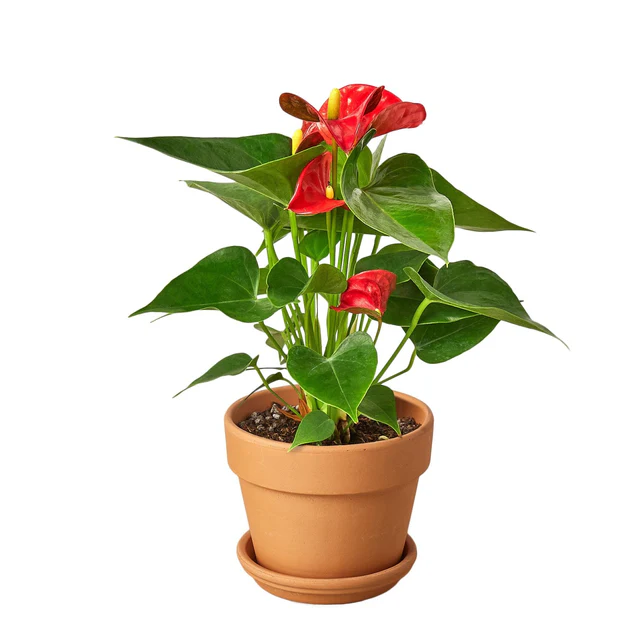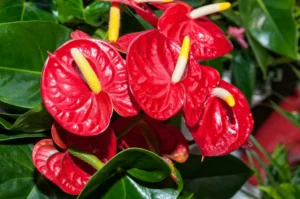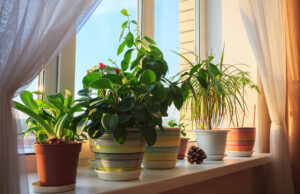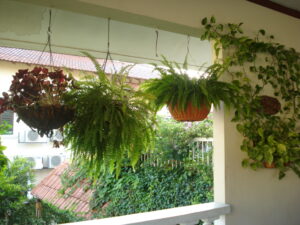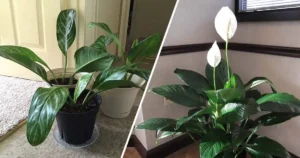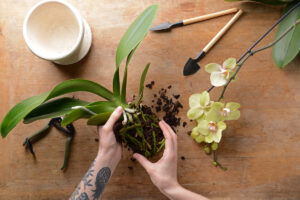Anthuriums, with their vibrant blooms and glossy foliage, have become a favorite among houseplant enthusiasts. Known for their exotic appearance, these tropical plants are often called “Flamingo Flowers” or “Laceleaf.” Whether you’re a seasoned gardener or a beginner looking to add a splash of color to your indoor space, learning how to plant, grow, and care for anthuriums is essential for maintaining their health and beauty.
On This Page
This comprehensive guide will walk you through every aspect of anthurium care, from choosing the right soil mix to ensuring your plants thrive in your home. By following these expert tips, you can enjoy the lush greenery and striking flowers of anthuriums year-round.
Understanding Anthuriums: What Makes Them Unique?
Anthuriums are native to the tropical regions of Central and South America, thriving in warm, humid environments. These plants belong to the Araceae family and are known for their heart-shaped leaves and long-lasting blooms, which can range in color from deep reds and pinks to whites and greens. The flowers, technically spathes, are often mistaken for petals, while the spadix, the spike at the center, is where the true flowers are found.
The Anatomy of an Anthurium Plant
Understanding the structure of an anthurium is crucial for proper care. The plant’s root system is shallow and prefers well-draining soil, while the leaves are broad, leathery, and can grow up to 12 inches in length. The spathes, which are modified leaves, are the most eye-catching part of the plant and can last for several weeks. The spadix, where the true flowers are located, is usually a contrasting color and can also produce berries after pollination.
Why Anthuriums Are Ideal for Indoor Growing
Anthuriums are well-suited for indoor environments due to their low light requirements and tolerance for household humidity levels. They not only add aesthetic value but also contribute to air purification, making them a perfect addition to any living space. Their ability to thrive in indirect light and moderate care needs makes them a favorite for both novice and experienced plant enthusiasts.
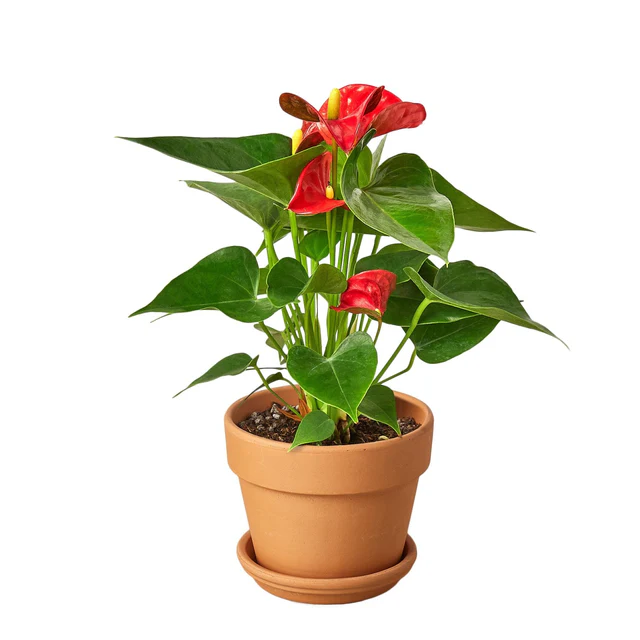
Add a touch of vibrant color to your home with the Anthurium Red. Shop now at Leaf & Clay and bring this stunning plant into your space.
Add a touch of vibrant color to your home with the Anthurium Red. Shop now at Leaf & Clay and bring this stunning plant into your space.
How to Plant Anthuriums: A Step-by-Step Guide
Planting anthuriums correctly sets the foundation for their healthy growth. Here’s how to ensure your anthuriums are off to a great start.
Choosing the Right Pot and Soil Mix
Selecting the appropriate pot is crucial. Anthuriums prefer slightly tight quarters, so choose a pot that is only a few inches larger than the root ball. The pot should have drainage holes to prevent waterlogging. The ideal soil mix for anthuriums is a well-draining blend of orchid mix, peat moss, and perlite. This mix mimics their natural epiphytic environment and provides the roots with adequate aeration.
Planting Procedure for Anthuriums
Begin by placing a layer of the soil mix at the bottom of the pot. Gently place the anthurium in the pot, spreading out the roots. Fill in around the roots with more soil mix, ensuring that the crown of the plant is slightly above the soil level. Water the plant thoroughly after planting to help the soil settle around the roots.
Growing Anthuriums: Essential Care Tips
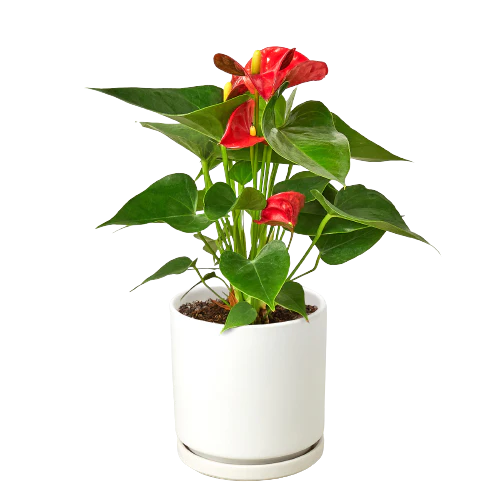
Anthuriums require specific care to thrive, but with the right conditions, they can produce beautiful blooms year-round.
Light Requirements for Anthuriums
Anthuriums prefer bright, indirect light. Direct sunlight can scorch the leaves, while too little light can result in poor growth and fewer blooms. Place your anthurium near a north or east-facing window where it can receive filtered light. If natural light is insufficient, consider using grow lights to supplement.
Watering Guidelines for Healthy Growth
Proper watering is critical for anthuriums. They prefer moist, but not waterlogged soil. Water the plant when the top inch of soil feels dry to the touch. During the growing season (spring and summer), water more frequently, reducing the frequency in the fall and winter. Overwatering can lead to root rot, so ensure excess water drains away.
Humidity and Temperature Requirements
Anthuriums thrive in high humidity environments, ideally between 60-80%. If your home is dry, especially during winter, consider using a humidifier or placing the plant on a tray filled with water and pebbles to increase humidity around the plant. Keep the temperature between 65°F and 80°F, avoiding drafts or sudden temperature changes that can stress the plant.
Long-Term Anthurium Care: Pruning, Repotting, and Troubleshooting
To keep your anthuriums healthy and encourage continuous blooming, regular maintenance is essential.
Pruning and Deadheading Anthuriums
Regular pruning helps maintain the plant’s shape and encourages new growth. Remove any yellow or dead leaves, and cut off spent flowers to direct the plant’s energy towards producing new blooms. Use clean, sharp scissors or pruning shears to make cuts just above a leaf node.
When and How to Repot Anthuriums
Repotting should be done every two to three years or when the plant outgrows its pot. Signs that your anthurium needs repotting include roots growing out of the drainage holes or the plant becoming top-heavy. Choose a slightly larger pot and fresh soil mix, following the planting procedure mentioned earlier.
Common Problems and Solutions
Anthuriums are relatively easy to care for, but they can face issues such as yellowing leaves, root rot, and pest infestations. Yellow leaves often indicate overwatering or inadequate light, while root rot is a result of poor drainage. To address these issues, adjust your watering schedule and ensure proper lighting. For pests like aphids or spider mites, treat the plant with insecticidal soap or neem oil.
Propagating Anthuriums: Expanding Your Collection
Propagation is a rewarding way to expand your anthurium collection or share plants with friends.
Methods of Propagation: Division and Stem Cuttings
Anthuriums can be propagated through division or stem cuttings. Division is the easiest method and should be done when repotting. Carefully separate the root clumps, ensuring each section has roots attached, and plant them in separate pots. Stem cuttings can also be rooted in water or a well-draining soil mix, though this method is slower.
Care for Newly Propagated Plants
Newly propagated anthuriums require extra care. Keep them in a warm, humid environment with bright, indirect light. Water sparingly until the plants are established, gradually increasing as they begin to grow. With proper care, your new anthuriums will thrive and eventually produce blooms of their own.
Conclusion
Caring for anthuriums is a rewarding experience that brings the beauty of tropical flora into your home. By following these expert tips on planting, growing, and maintaining these stunning plants, you can enjoy their vibrant colors and lush foliage year-round. Whether you’re looking to enhance your indoor garden or simply want to add a touch of nature to your living space, anthuriums are a perfect choice. With proper care, they will continue to thrive, bringing joy and elegance to your home.

